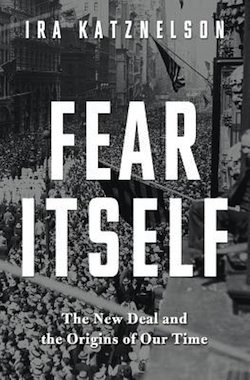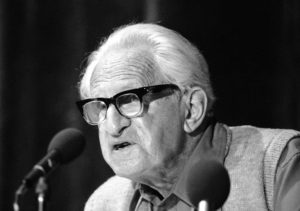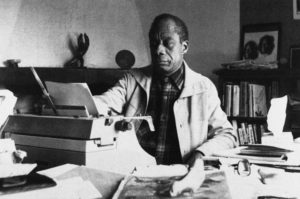Fear Itself
Good and evil are inseparable in history: "Liberal democracy prospered because of an accommodation with racial humiliation," writes Ira Katznelson in "Fear Itself: The New Deal and the Origins of Our Time."Good and evil are inseparable in history: "Liberal democracy prospered because of an accommodation with racial humiliation," writes Ira Katznelson in "Fear Itself."
“Fear Itself: The New Deal and the Origins of Our Time” A book by Ira Katznelson
Franklin D. Roosevelt’s New Deal, World War II and Harry S. Truman’s Fair Deal that followed saved both capitalism and representative democracy — a historic triumph. But as historian Ira Katznelson argues persuasively in this engrossing book, “the triumph … cannot be severed from the sorrow.” At home, Katznelson writes, “liberal democracy prospered because of an accommodation with racial humiliation” — the flagrant racism of the Jim Crow South. Abroad, victory in World War II depended on an alliance with Josef Stalin, a tyrant in the class of Adolf Hitler. Then to cope with Stalin’s Soviet Union early in the Cold War, we relied on Hitler’s Nazi scientists and engineers to build our rockets.
Such contradictory combinations of good and evil recur throughout Katznelson’s story, revealing basic truths about the complexities of human history.
It is an exhilarating pleasure to lose yourself in this old-fashioned example of original historical scholarship. “Fear Itself” is a sprawling, ambitious book that offers illuminating insights on nearly every page. Among Katznelson’s gifts is the one most valuable to readers, and most in danger of extinction in the American academy: He writes clear, energetic prose without a whiff of academic jargon or pretension.
Katznelson, the Ruggles professor of history and political science at Columbia University, demonstrates that Congress’ approval of Roosevelt’s New Deal depended on the support of racist Southern Democrats, who were happy to support FDR’s liberal and occasionally radical economic ideas, provided they did not disrupt the Jim Crow culture of the South. FDR willingly accepted this bargain. So poor black Southerners were deliberately excluded from many New Deal programs, beginning with Social Security, which initially did not cover agricultural and domestic workers, the principal occupations of Southern blacks. Again and again, Katznelson shows, Southern members of Congress made sure that African-Americans were shortchanged, even by the GI Bill of Rights and the Tennessee Valley Authority, which actively discriminated in its employment policies and favored white institutions over black ones.
The book is being published on the 80th anniversary of FDR’s first inaugural address, delivered on March 4, 1933. Its most famous line provided Katznelson’s title: “The only thing we have to fear is fear itself — nameless, unreasoning, unjustified terror which paralyzes needed efforts to convert retreat into advance.”
Katznelson considers “fear itself” more than a rhetorical flourish. He argues, again persuasively, that historians beguiled by Roosevelt’s successes have failed to appreciate the degree to which fear had unhinged the nation in 1933, or that fear persisted for more than 20 years, coloring our history at every turn and influencing it still. Those two decades are Katznelson’s subject, despite his subtitle’s reference to the New Deal; his rich narrative takes us from 1933 to the inauguration of Dwight D. Eisenhower in 1953.
Roosevelt restored America’s spirits, saved liberal democracy and led the Allies to victory over Hitler and the Japanese, but he never dispelled the fear. Sometimes he aggravated it — for example, by interning Japanese Americans as if they deserved to be feared. And under Roosevelt’s successor, Truman, the arrival of the atomic bomb and the Cold War sharply raised the level of national anxiety. It was an age of fear.
The role of Southern white members of Congress in the New and Fair Deal eras is not a new subject for Katznelson, but he dissects it here compellingly, reminding us painfully how crudely racist American society was just one human lifetime ago. FDR was caught in “a Southern cage,” he writes, and he provides lively descriptions of its occupants and their hair-raising prejudices. Perhaps the most vivid character sketch is of Sen. Theodore Bilbo of Mississippi, a Neanderthal whose name was so easy to laugh at, but whose rhetoric was anything but laughable in its use of racial epithets for African-Americans and its disparagement of Catholics and Jews.
Yet Bilbo, a staunch New Dealer, and his fellow Mississippians in Congress were crucial allies of FDR’s. So when Northern Democrats tried to pass anti-lynching legislation in 1934, FDR refused to help. “If I come out for the anti-lynching bill,” Roosevelt told Walter White of the NAACP, Southern members “will block every bill I ask Congress to pass to keep America from collapsing. I just can’t take that risk.” Again and again the Southerners provided crucial votes, not just for New Deal legislation in the early 1930s, but also on measures to prepare for World War II. In August 1941, for example, Roosevelt won a House vote to strengthen the military draft in obvious preparation for war by a single vote, 203-202. Southern members voted 123-8 in favor. The pattern recurred after the war, when Southern members gave strong support to Truman’s forceful Cold War policies.
Katznelson takes his readers on an entertaining and enlightening journey through the ’30s and ’40s, reminding us of how far we have come in the subsequent six decades. He recounts obscure events that illuminate those years — for example, the long-forgotten 1933 tour of Europe and the United States by 25 Italian seaplanes commanded by Fascist Italy’s aviation minister, Italo Balbo. At the time Balbo was widely compared to Charles Lindbergh and welcomed in America as a hero, warmly received by Time magazine (which put him on its cover) and numerous American public figures. Benito Mussolini was a sympathetic figure in the early ’30s, Katznelson reminds us — an example of the ambivalent attitudes Americans brought to the European crisis that worsened steadily through that decade.
|
To see long excerpts from “Fear Itself” at Google Books, click here. |
Katznelson seems to have read everything written about these two decades. His detailed footnotes — worth reading with care — fill 172 pages at the back of this thick volume. He makes wonderful use of quotations from the principal actors in his story, and also from scores of scholars who have written on his subjects. He has also done extensive research on voting in Congress in these years to demonstrate the critical role played by Southern Democrats. This work produced some dense, overly detailed passages, the only unwelcoming sections of the book. He could have shared fewer numbers.
The author can appear romantically unrealistic about some of his own liberal inclinations. For example, he suggests that the United States would have developed a strong national labor movement deeply involved in politics — the sort of trade union movement seen later in the 20th century in Western European countries — had it not been for the Taft-Hartley Act. This law, enacted over Truman’s veto in 1947 by the same Southern Democrats who were so important to passing the New Deal, certainly did impede American unions, which represented about a quarter of all workers at the end of World War II. But there were many other influences that discouraged the evolution of a labor party in this country.
There is more to quarrel with here, but insufficient space in this review to conduct a debate with the author. And the quarrelsome material only adds to the fun of reading this book. More important, there is no quarreling with Katznelson’s largest conclusions: These 20 years “dramatically altered the context within which American politics operated. … (They) successfully initiated a durable shift in governing authority that brought a new national state into being.” This is a state with a much-enlarged role managing the affairs of the country at home, and “an assertive state that crusaded almost without limits (abroad) for American power and values.” The New Deal (and the Truman years that followed) “proved to be a rejuvenating triumph,” albeit one that “flourished with ethical compromise” with racists at home and dictators abroad. History truly is complicated.
Robert G. Kaiser is an associate editor of The Washington Post. His latest book, “Act of Congress, How America’s Essential Institution Works, And How It Doesn’t,” will be published in May. He can be reached at [email protected].
©2013, Washington Post Book World Service/Washington Post Writers Group
Your support matters…Independent journalism is under threat and overshadowed by heavily funded mainstream media.
You can help level the playing field. Become a member.
Your tax-deductible contribution keeps us digging beneath the headlines to give you thought-provoking, investigative reporting and analysis that unearths what's really happening- without compromise.
Give today to support our courageous, independent journalists.






You need to be a supporter to comment.
There are currently no responses to this article.
Be the first to respond.